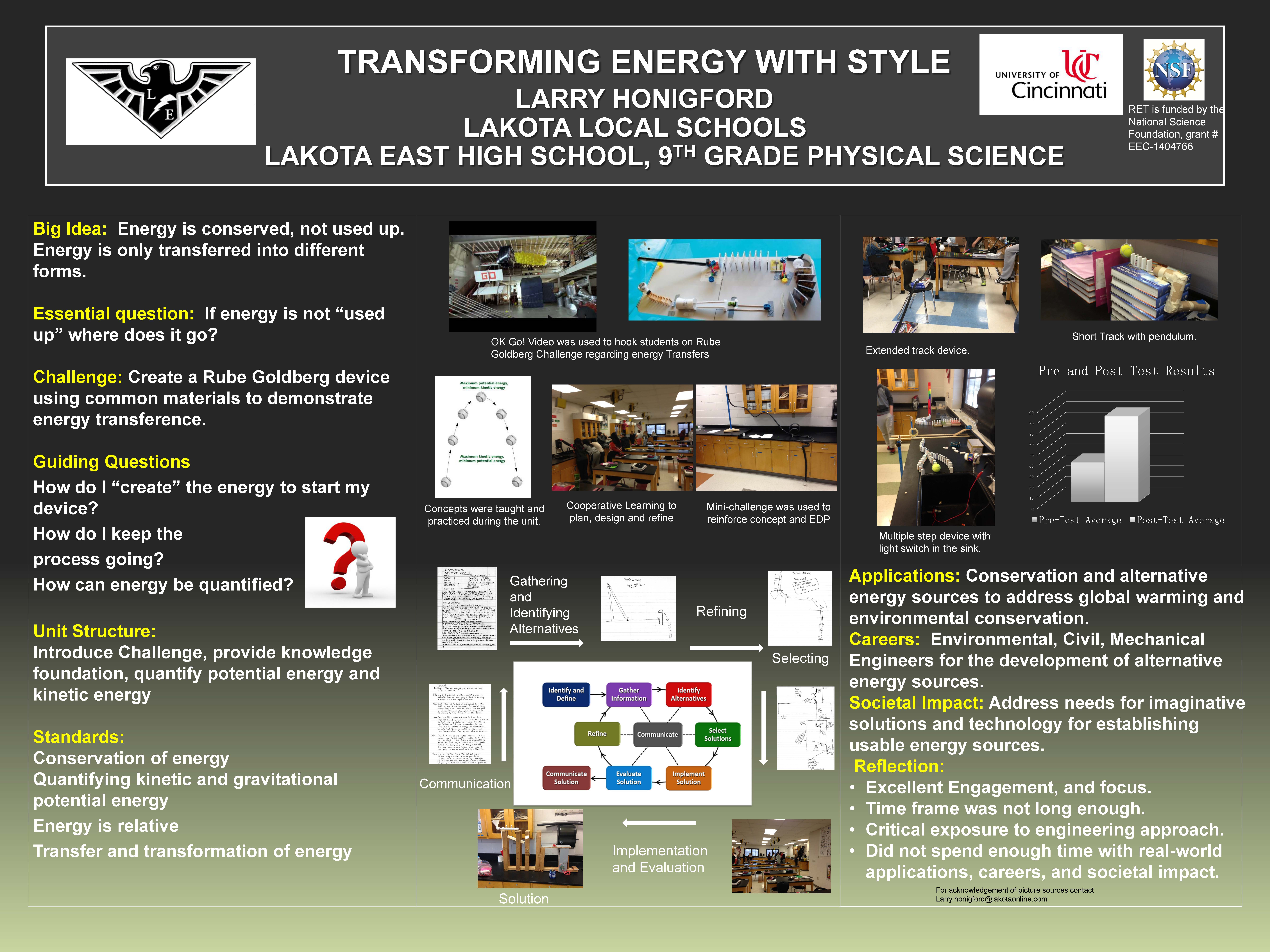Research Experience for Teachers (2015-2016)
Transforming Energy With Style
 |
||||||
|
||||||
|
Pre/Post Test: Pre-Test Post-Test |
||||||
|
The Big Idea (including global relevance) Generation of energy is really not an accurate statement. |
|
Essential Questions What happens to energy as it is “used”? |
|
The Hook
The Hook will also introduce the challenge. The musical group OK-Go! produced a music video called “This too shall pass” using a Rube Goldberg Device |
|
The Challenge Design and construct a Rube Goldberg device to complete a circuit to flip a switch to turn on a light bulb. |
|
Guiding Questions
|
ACS (Real world applications; career connections; societal impact)
The Rube Goldberg devices themselves are not a needed commodity when thinking of real world application. However, the concept of conservation of energy is an extremely important concept when considering issues such as global warming and environmental conservation.
The establishment of the device, again has limited direct societal impact, but rather an indirect link to the idea that our imagination and technology are the limiting factors for establishing usable energy sources.
Careers include engineers in various fields working to develop new energy and more environmentally energy sources including renewable energy sources such as wind and solar power. Also the need for supporting infrastructure for these types of energy sources for the use of storage and delivery on an as needed bases.
Misconceptions
- Energy is used up or lost in a system.
- We are running out of energy.
- An object at rest has no energy.
Unit Lessons and Activities
- Lesson 1: During this lesson the students will work on the concept of the Law of Conservation of Energy, forms of energy and energy transformation.
- Activity 1: Includes the Hook, leading activity for the Big Idea and introduction for the challenge. - 2 days
- Activity 2: Introduces types of energy, Law of Conservation of Energy, and energy transformations. - 2 days
- Lesson 2: During this lesson the students will learn to quantify energy with respect to kinetic and potential energy. They will also learn how the two relate to each other in a system. Math application of the kinetic energy and potential energy formulas will be included. A mini-challenge will also be performed requiring the students to design rollercoasters.
- Activity 3: The students will be practicing application of the kinetic and potential energy formulas using real-life examples. They will also be working with systems in which they will relate potential and kinetic energy to each other. They final 2 days will be the mini-challenge of designing and building a rollercoaster. - 5 days
- Activity 4: Includes testing and final presentation for student solutions. One day allows student refinement under the EDP. - 2 days
- Evidence of CBL:
- Evidence of EDP: Lesson 2, Activity 4
Additional Resources
Activity # 1 would require presentation of videos and access to computers to run the virtual site.
Activity # 2 requires several worksheets and PE & KE Tracks and large marbles.
Activity # 3 requires worksheets to practice calculation for kinetic and potential energy. Softball toss package and graphing packet. For Roller coaster mini-challenge foam piping insulation cut in half lengthwise, masking tape, small marbles.
Activity # 4 most materials will need to be acquired at home by the student to complete the Rube Goldberg device. It is anticipated the many household items which are readily available will be used. This activity does not require any purchasing.
